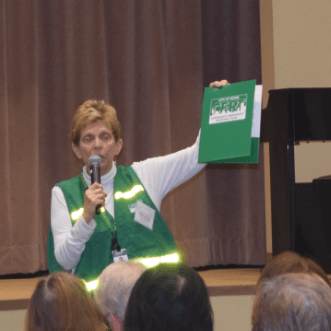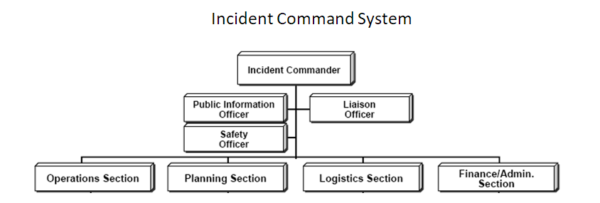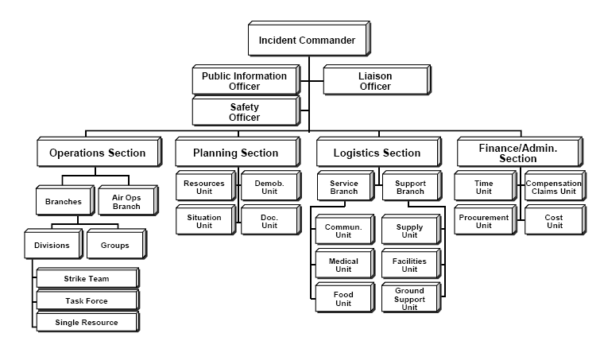
I’m a very big fan of Community Emergency Response Team (CERT) training. I took the course in 2001, and have been happily participating as a volunteer in various follow-up activities once or twice a year since. Accordingly, this summer Joe and I took a refresher course on NIMS, the National Incident Management System. We just finished it up last week.
With both hurricane and fire season ramping up, it felt like a good time for a review!
Here’s how we respond to emergencies in the U.S.

Citizens are usually the victims of an emergency — which also makes them the very first responders!
CERT members are citizen volunteers trained to respond – to help themselves and others.
Now when CERT members are activated by their sponsoring agency (police or fire department), they may find themselves working with other local volunteers, perhaps from a different city. They could easily be working with local or borrowed first responders – police and fire departments or emergency medical personnel – and maybe even other city, state or national agencies including the National Guard.
In a disaster you could find yourself surrounded by all sorts of professional responders — and all of them strangers. How would you be able to work with them?
Because of NIMS, everyone is able to work together!
Per FEMA, the purpose of NIMS is to “guide all levels of government including territories and tribes, nongovernmental organizations like the Red Cross, and the private sector (including families, faith-based organizations, etc.) to work together to prevent, protect against, mitigate, respond to, and recover from incidents of all sizes, in all locations, no matter how simple or complex.”
That’s a tall order!
The way I understand it, what NIMS really does is give everyone involved in an incident three important assets:
- shared vocabulary
- an agreed-upon management system that expands to coordinate disaster responders on the local, state and federal levels
- a standardized approach to a specific on-the-ground incident
The “on-the-ground,” tactical component of NIMS is the ICS or Incident Command System.
As a neighborhood response team member, or as a CERT volunteer, you are most likely to be exposed to the ICS. Here’s how its underlying principle has been described to me: “The first person to arrive becomes the Incident Commander, until someone more senior/experienced takes over.” The command chain builds out, step by step, using a common hierarchy to incorporate as many people or teams as necessary. As the problem is resolved, the chain contracts.
Here are a couple of diagrams that will help explain the ICS:

The chart above shows the basic structure. At the top, the Commander, who is supported by a public information officer, safety officer and liaison officer. Directly under the Incident Commander are four “Sections.” Even your simple neighborhood disaster will have an Incident Commander and an Information Officer. You might also have Sections (though probably not a Finance section).
Below is a chart of a “fully expanded” Incident Command System. It shows the sub-groups associated with the various Sections. Again, if you are a small neighborhood group, like we are, your Operations Section might have Division Leaders (and Block Captains), all reporting up the chain to the Incident Commander. If you are able to field Special Teams (medical, search & rescue, etc.) they might logically fall into the Logistics Section.

How did this all come to be?
After the terror of September 11, 2001, followed by the chaos of Hurricane Katrina in 2004, the nationwide approach to emergency management underwent dramatic changes. NIMS was formalized. Today, all official emergency management groups in the U.S. follow the NIMS system, and all “incidents” are managed using ICS, the Incident Command System.
If your community experiences a disaster, whoever comes to help will be following these systems. You will be far more useful and confident if you are familiar with the set-up and the vocabulary!
And if you are building your OWN citizen community teams, consider how they might fit into this same national framework. Of course, you don’t have to have every position. But try to choose titles for your positions that reflect the “official” vocabulary. You’ll find it far easier to integrate with professionals when they finally do arrive on the scene.
This short article is not really sufficient to explain the full system. Here are a couple of official resources for citizen volunteers.
(1) FEMA offers a series of online courses for volunteers and professionals at https://training.fema.gov/nims/ Start with IS-100 (a. is the original, b. and c. are updates).
(2) You can also purchase a book from Amazon, authored by FEMA, so you can have it to refer to at a meeting or in the field. Click on the image or on the link below for further details and price. (less than $10 as I write this.)

IS-100.B: Introduction to Incident Command System, ICS-100
Once again, please remember I’m writing this article after long-time familiarity but I’m not a professional emergency manager. Still, I hope you’ll get a helpful overview. Please feel free to comment with corrections or suggestions!
Virginia
Your Emergency Plan Guide team
Don't miss a single Advisory.
Thank you for subscribing.
Something went wrong.
